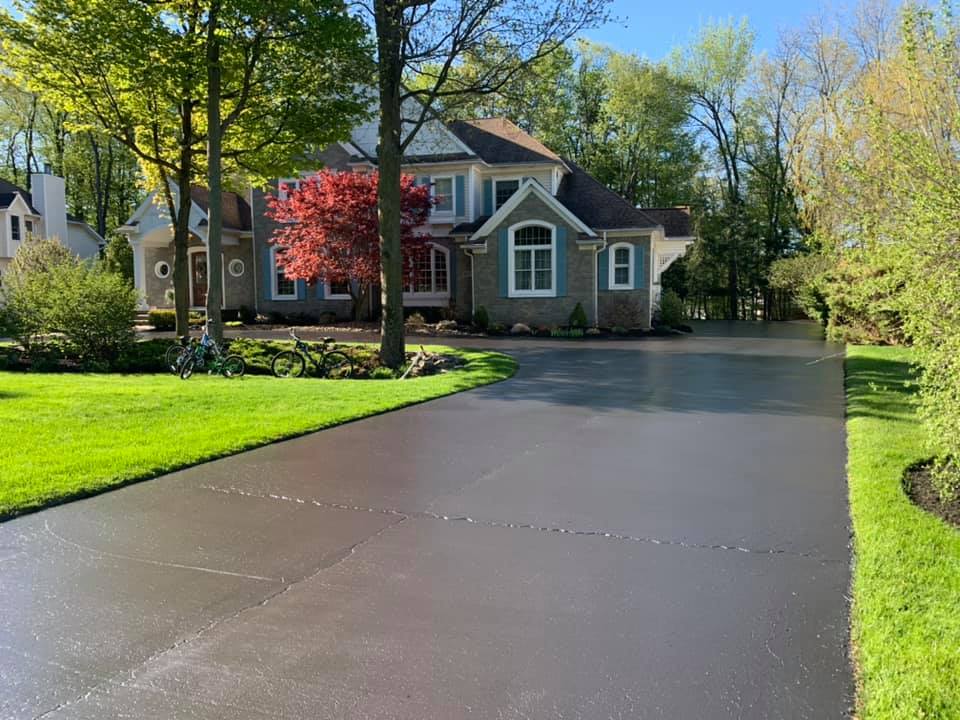Mastering Tilted Parking: How Asphalt Sealing Improves Industrial Lots
Mastering Tilted Parking: How Asphalt Sealing Improves Industrial Lots
Blog Article
Hot Mix Asphalt: A Sustainable Remedy for Pavement
Warm Mix Asphalt (HMA) has actually arised as a leading sustainable choice for pavement remedies, supplying a myriad of environmental benefits and cutting-edge modern technologies. As the demand for eco-friendly building and construction techniques grows, discovering the nuances of HMA's sustainability can offer beneficial insights right into the future of sidewalk remedies.
Environmental Benefits of Hot Mix Asphalt

Furthermore, Warm Mix Asphalt assists to reduce urban warmth island impacts. Its dark color absorbs sunlight, minimizing the amount of warmth reflected back into the ambience compared to lighter-colored pavements. This can reduce ambient temperature levels in city locations, decreasing the need for air conditioning and eventually decreasing power consumption.
Additionally, Warm Mix Asphalt adds to improved stormwater administration. Its porous nature enables water to reenergize and infiltrate the pavement groundwater materials, minimizing runoff and the risk of flooding. These environmental benefits make Warm Mix Asphalt a lasting selection for leading roads and highways.
Power Efficiency in HMA Manufacturing
Is power effectiveness a critical element in the manufacturing of Warm Mix Asphalt (HMA)? Definitely. Power plays a substantial function in the manufacturing of HMA, influencing both price and ecological sustainability. One key facet of energy efficiency in HMA manufacturing is making use of warm mix asphalt (WMA) modern technologies (commercial parking lot paving). WMA permits the mixing and placement of asphalt at lower temperature levels compared to standard warm mix asphalt, resulting in decreased power consumption during manufacturing. This procedure not just reduces gas use however likewise lowers greenhouse gas exhausts, making it a more eco-friendly choice.
Furthermore, innovations in plant innovations have actually caused more energy-efficient HMA production processes. Modern plants are made with attributes like recycled asphalt pavement (RAP) processing capacities, reliable burner systems, and improved insulation, all adding to power financial savings. By maximizing energy usage in HMA manufacturing, the sector can minimize its carbon impact while maintaining high-grade sidewalk materials. Energy performance is, as a result, a vital factor to consider in making certain the sustainability of Warm Mix Asphalt manufacturing.
Recyclability of Warm Mix Asphalt
The recyclability of Hot Mix Asphalt (HMA) is a critical aspect of its sustainability and long-lasting ecological effect. HMA is among one of the most recycled materials in the United States, with over 100 million lots of recovered asphalt pavement (RAP) being reused annually in brand-new sidewalk construction. Recycling HMA uses several ecological benefits, such as reducing the demand for virgin products, reducing energy intake during production, and lowering the quantity of waste sent out to land fills.
The procedure of reusing HMA entails crushing the existing pavement, squashing it into smaller sized pieces, and blending it with brand-new aggregate and asphalt binder to create a recycled mix. This recycled mix can frequently do in browse this site addition to and even far better than conventional HMA, while needing fewer raw products and generating lower greenhouse gas discharges. By integrating RAP right into brand-new sidewalk tasks, roadway companies can preserve natural deposits, minimize prices, and reduce the ecological impact of road building and construction and upkeep activities. On the whole, the recyclability of HMA plays a considerable function in advertising sustainable practices within the pavement sector.

Long-Term Efficiency of HMA
Asphalt pavements show resilience and durability over a prolonged duration, showing the long-lasting efficiency of Hot Mix Asphalt (HMA) Furthermore, developments in HMA technology, such as the use of polymer-modified binders and cozy mix asphalt, have additionally enhanced the resilience and longevity of HMA sidewalks. By focusing on high quality construction and maintenance practices, HMA proceeds to confirm itself as a cost-effective and lasting option for resilient sidewalk framework.

HMA: Durability and Sustainability
Demonstrating both longevity and sustainability, Hot Mix Asphalt (HMA) has actually become a cornerstone in the construction of durable pavement facilities - hot mix asphalt. HMA's resilience stems from its ability to hold up against hefty lots, rough weather, and high web traffic volumes, making it a trusted choice for roadways, freeways, and flight terminal runways. The structure of HMA, which usually includes aggregates, binder, and filler, plays a vital role in improving its long life and resistance to try these out wear and tear
Additionally, HMA's sustainability exists in its recyclability and energy-efficient manufacturing process. The ability to reuse recovered asphalt sidewalk (RAP) in brand-new HMA mixes reduces the demand for virgin products and lessens the ecological influence of pavement building and maintenance. Additionally, the power efficiency of producing HMA lies in its reduced mixing temperature levels contrasted to various other sidewalk materials, leading to reduced energy consumption and greenhouse gas emissions.
Conclusion
Finally, warm mix asphalt (HMA) offers a sustainable option for pavement with its eco-friendly features. HMA's recyclability, energy performance in production, and long-term toughness make it an eco-friendly selection for roadway building. By preserving natural sources, lowering waste, and lowering greenhouse gas emissions, HMA plays a learn the facts here now crucial function in advertising sustainability in facilities advancement. Its ability to reduce city heat island impacts even more underscores its significance in producing environmentally aware and resilient sidewalk systems.
HMA is one of the most recycled products in the United States, with over 100 million loads of reclaimed asphalt pavement (RAP) being recycled yearly in brand-new sidewalk building.The procedure of recycling HMA involves crushing the existing pavement, crushing it right into smaller sized pieces, and mixing it with brand-new aggregate and asphalt binder to create a recycled mix.Asphalt pavements show longevity and strength over an extended duration, mirroring the lasting efficiency of Hot Mix Asphalt (HMA) Additionally, advancements in HMA technology, such as the usage of polymer-modified binders and cozy mix asphalt, have actually further boosted the longevity and durability of HMA sidewalks. The ability to recycle recovered asphalt pavement (RAP) in brand-new HMA mixtures minimizes the need for virgin materials and minimizes the environmental effect of pavement building and maintenance.
Report this page